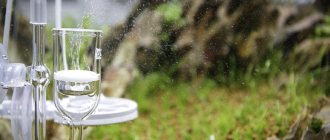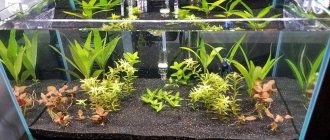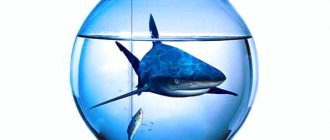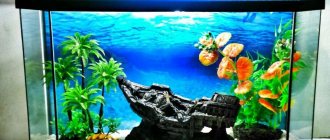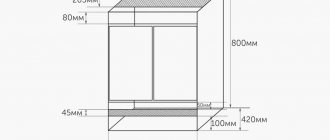Not all plants are suitable for spawning; the most popular are Riccia floating and Java moss, which can grow into dense clusters. However, if you did not plan to breed, but suddenly discovered that the fish are showing clear signs of the beginning of the mating season, you may not be able to quickly find such plants.
There is a fairly old, but effective and cheap way to create artificial plants for spawning at home. These are bundles of woolen threads floating on the surface or attached to the bottom. For spawning, it is recommended to use a separate tank so that the fish have no other alternative where to disperse their eggs. When the mating season arrives, take a simple three-liter jar or any other container of suitable volume, fill it with water from the aquarium and place artificial plants.
How to Clean Artificial Aquarium Plants
Aquarium artificial plants and decorations can be quite difficult to clean, especially when they are thickly covered with algae. There are several basic recipes on how to best clean them.
Looking ahead, I will say: Never try to clean algae with soap and water or using highly toxic cleaning products.
By placing artificial plants in the aquarium after this cleaning, you can see the rapid death of all your fish. I seriously doubt that this is what you are trying to achieve.
The aquarium needs to be cleaned regularly. It is advisable to combine these actions.
A normally functioning aquarium is home to beneficial bacteria, and removing everything from the aquarium environment at once can eliminate or greatly weaken the colony of these bacteria.
If possible, try to wash aquarium decorations and plastic plants one at a time, rather than all at once, in one day.
There are several effective and safe ways to clean aquarium artificial plants.
So…
How to make your own seaweed
Our project lives and develops for those who are looking for answers to their questions and strive not to get lost in a stormy sea of often useless information. On this page we told (or rather, showed you how to make seaweed with your own hands. In addition, we found and added for you thousands of other videos that seem to be able to answer any of your questions. However, if the site still did not contain information of interest - write to us, we will prepare it for you and add it to our website! If it’s not difficult for you, please leave your feedback on how complete and useful the information posted on our website was about How to make seaweed with your own hands.
On this page we told (or rather, showed you how to make seaweed with your own hands. In addition, we found and added for you thousands of other videos that seem to be able to answer any of your questions. However, if the site still did not contain information of interest - write to us, we will prepare it for you and add it to our website! If it’s not difficult for you, please leave your feedback on how complete and useful the information posted on our website was about How to make seaweed with your own hands.
smotrikak.ru
How to clean artificial aquarium plants?!
Using boiling water
Hot water easily kills algae deposits, making your decorations easy to clean. It is best to use this method as it causes absolutely no harm to your aquarium fish.
But it will add some physical work to you with a scraper.
Cleaning recipe using boiling water:
- Boil water
- Place plants in boiling water
- We wait 10-15 minutes
- Using a scraper to remove algae
- Place it back into the aquarium
Sometimes it is acceptable to use a bleach solution, since only this, in rare cases, can help get rid of algae on plants.
However, be aware that bleach may discolor some or all of your plants and cause significant harm to your fish if you do not wash it off completely. To be honest, the discoloration effect can only be seen when cleaning really cheap aquarium products.
High-quality plastic aquarium plants are coated with a special varnish that can withstand exposure to bleach.
Never use bleach when cleaning artificial driftwood and coral. Also, do not mix bleach with other substances to create a more vigorous mixture.
How to remove green plaque: basic subtleties
To quickly wash and clean the aquarium, you must strictly follow the sequence of work. The process consists of several stages. Necessary:
- Remove green deposits from the walls. The first step is to clean the glass surface with a special scraper without draining the water. For difficult to clean areas, use a blade.
- Pump out old water using a pump. To do this, dip one end of the hose in water and lower the other into a bucket. It is good to purchase a new bucket that will only be used to wash the tank.
- Clear the rocks at the bottom of excrement and food residues. You can remove them using a siphon pump, after removing the decorations and decor. Pump over the rocks. If you only have sand, you only need to use a pump hose, keeping it at a distance of 2.5 cm from the ground. This will prevent the sand from being absorbed. Using a rubber gloved hand or a spatula, gently “loose” the gravel or sand at the bottom. In this way, you can achieve deep cleaning of the soil, since the particles of debris in it will rise up.
- Wash jewelry and decor. These elements also need to be cleaned, since plant spores may be present on their surface. If the elements are heavily soiled and will be difficult to wash, then one of the cleaning methods is to use bleach. You need to leave the products in the solution for 15 minutes, and then rinse the cleaned decor with boiling water.
- Pour in clean, settled or filtered water. Monitor its temperature with a thermometer. After pouring in the water, wait a few hours for the rising particles to settle to the bottom and the water to become clearer.
- Clean the outside of the aquarium using special detergents, soda or wine vinegar. Dampen a sponge or rag with cleaning solution and thoroughly wipe all surfaces of the external elements, starting with the lamp and ending with the glass and lid.
If you maintain a favorable microclimate in your home pond and your fish are healthy, then you can clean the aquarium once a week, replacing 10-20% of the water volume. When your pets are sick, you need to rinse the aquarium more often and change all or 50-70% of the water.
Changing the water in the aquarium
Useful tips
Get yourself snails in your aquarium; they will eat most of the algae before all the above operations are required. Mollies are also very helpful in removing algae.
If algae appears suddenly and in large quantities, eliminate the cause of the algae outbreak before cleaning the plastic plants.
Other interesting articles
- Why not all plants in an aquarium are algae It is logical to assume that aquatic plants are algae. From the words “water” and “grow”. Just this…
- How to properly grow plants from seeds in an aquarium Growing aquarium plants from seeds is an interesting and exciting activity. But it comes with certain...
- How to treat plants for filamentous algae in an aquarium When filamentous algae or filaria appear in an aquarium, they grow quickly. They braid stones and plants with thin threads...
How to clean an aquarium
To properly clean the inside of the vessel, it should be washed using special equipment.
Necessary tools and accessories to clean the aquarium:
- Glass scraper for removing plaque and algae.
- Soil cleaner – .
- Bucket or bowl.
- Net.
The scraper must be selected according to the type and size, relative to the type of aquarium. The most expensive and convenient option is a magnetic scraper that collects dirt by running along the outside of the wall. The pond can be washed with a regular sponge, without impregnation with cleaning agents.
A soil cleaner is required to be able to clean the substrate without removing it from the container. If you plan to significantly or completely change the water inside the vessel, you must purchase a net for the safety of the fish. The net should be selected relative to the size of the pet so as not to damage the delicate fins.
When washing, you can use baking soda as a cleaning agent. It is important to rinse off the soda thoroughly.
What cleaning products can you use?
It is not recommended to use cleaning chemicals to clean the reservoir, as there is a risk of leaving particles of the substance inside the vessel. The remaining product can cause significant harm to the health and life of the inhabitants. Baking soda can be used, but this substance is also harmful to pets. After cleaning the aquarium with soda, it must be rinsed with running water several times.
If you still need to use strong chemical mixtures, you can use:
- Soap.
- Domestos.
- Comet.
An important rule when using such products is to thoroughly rinse the container with water.
Work away from civilization
70 people work at four procurement sites of the plant in different parts of the Solovetsky archipelago and off the coast of Karelia. Procurers come to the islands for the summer season; in winter the village is empty. “They don’t live here all the time, only four months a year. Workers come from Ukraine, Belarus, from Russian regions - the Arkhangelsk region and others, some even come from the Krasnodar Territory,” says Korotenkov.
“The main core consists of approximately 20% of experienced craftsmen who support production, and the remaining 70–80% are newcomers. It happens that someone doesn’t do well; not everyone is ready to work in such risky conditions,” he notes. Residents of the southern regions find it difficult to get used to not only the weather conditions, but also the unusual fauna for them. On Solovki they tell how one worker, who came from Ukraine, fell into a panic when he saw a seal emerge near his boat and mistook it for a waterman - a bald, mustachioed old man. The pinnipeds of the White Sea are not at all afraid of algae harvesters - they continue to rest on rock piles, even when a boat with a motor passes nearby, and sometimes they themselves swim up to the seaweeds, emerging near them.
Seasonal workers are provided with food and temporary housing in a coastal village. “Some come here with their families. As a rule, they show the best results in harvesting,” says Korotenkov.
The wives of the food processors work in the dining room, help dry seaweed, and arrange everyday life. The harsh northern climate and short summer do not allow them to engage in agriculture to the fullest, but the village residents try to grow at least the simplest vegetables and herbs - cucumbers, radishes, parsley. Electricity in the village is generated by a generator, which is turned on according to a schedule or when necessary. There is no running water; the houses are heated by stoves. “For such a production model, living conditions are normal, the rest depends on the person,” says Korotenkov.
Helper fish
For additional help in daily cleaning of the aquarium, you can get nurse fish. There are species of fish that feed on unicellular algae, thereby saving the artificial reservoir from unnecessary sedimentation of plaque. However, these pets are only helpers and begin to eat algae only when they feel hungry.
Useful tips for cleaning an artificial pond:
- How often it is necessary to completely wash a reservoir depends on individual indicators and the speed of its pollution; you should not perform unnecessary manipulations by interfering with the life of the reservoir. As a rule, the procedure is carried out once every 2 weeks.
- If possible, it is recommended to avoid using cleaning products.
- Plant supports should not be washed.
- If the new aquarium is large, then cleaning should be done at the installation site, and detergents should not be used, since in such conditions there will be a struggle with chemical particles that are difficult to wash off.
- Hydrogen peroxide can be used to wipe down a new aquarium;
- All cleaning equipment must be safe and used only for one pond.
- It is not recommended to feed the fish several hours before washing the vessel.
Wash your home aquarium thoroughly, following all the recommendations, and then the artificial pond will delight you with its beauty, and the fish and other pets will be healthy and attractive.
What is needed for cleaning?
Having eliminated all the causes of plaque, it is necessary to properly clean the ecosystem of algae. How to clean and what to wash the aquarium with? Cleaning an aquarium at home requires the availability of special equipment, which can be purchased at any place where aquarium fish are sold.
To clean the aquarium you will need:
- a scraper to remove algae from glass;
- water container, volume from 10 l;
- prepared replacement water in sufficient quantity;
- filter accessories;
- siphon type pump;
- aquarium glass cleaner;
- baking soda or wine vinegar to clean the aquarium;
- 10% bleach solution;
- blade.
Washing and cleaning a new aquarium
Also requires washing. However, you should not wash the vessel so thoroughly for the first time. A small container can be rinsed with running water in the bath, where it will be as convenient as possible. It is recommended to rinse the aquarium with not hot water, using a sponge. Water that is too hot can damage the glass walls of the vessel.
If there is any doubt about the cleanliness of the vessel, then you can use baking soda, it is not recommended to use soap, and before starting the vessel you need to make sure that all particles of the cleaning agent are washed off. To do this, the aquarium is rinsed at least 4 times under strong pressure. When cleaning is completed, the aquarium must be rinsed with clean, chlorine-free water. To do this, tap water should be allowed to stand for several days.
The purchased substrate also needs to be washed. The soil is washed without the use of chemicals until the water becomes clear. The new filter also needs to be thoroughly washed. All decorative items are also washed, but using baking soda.

